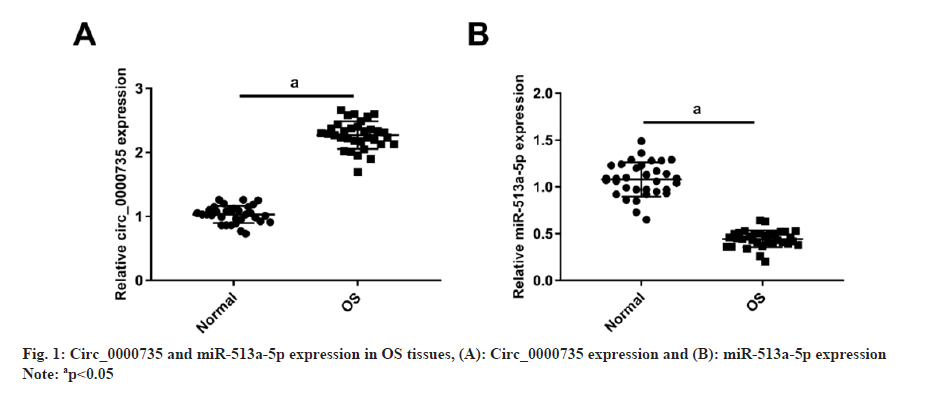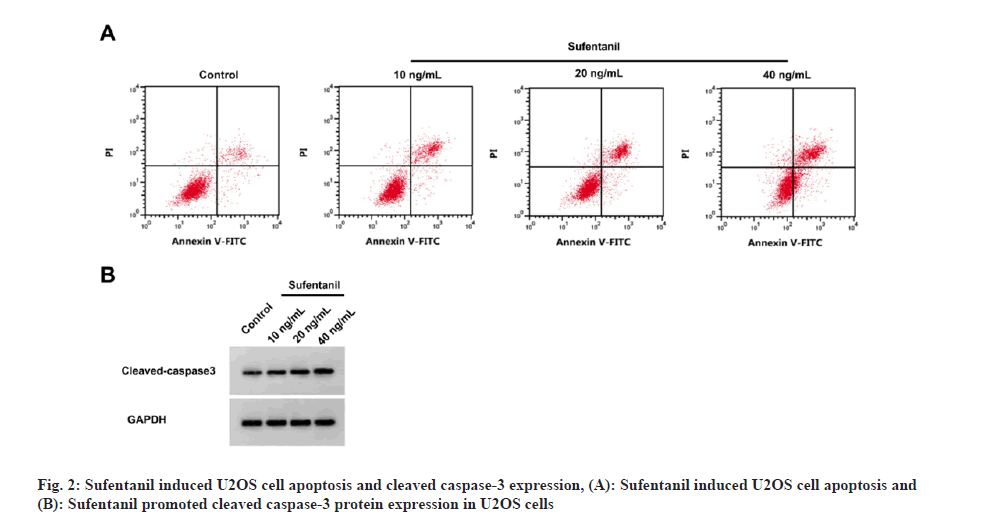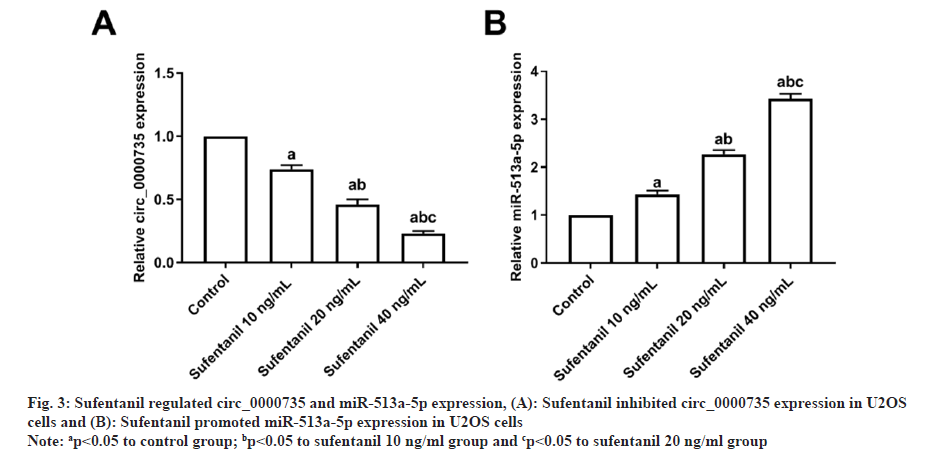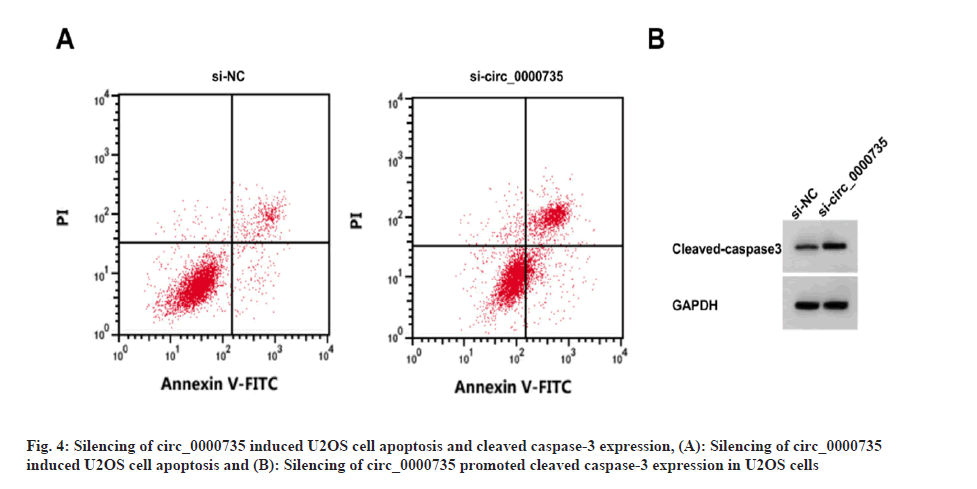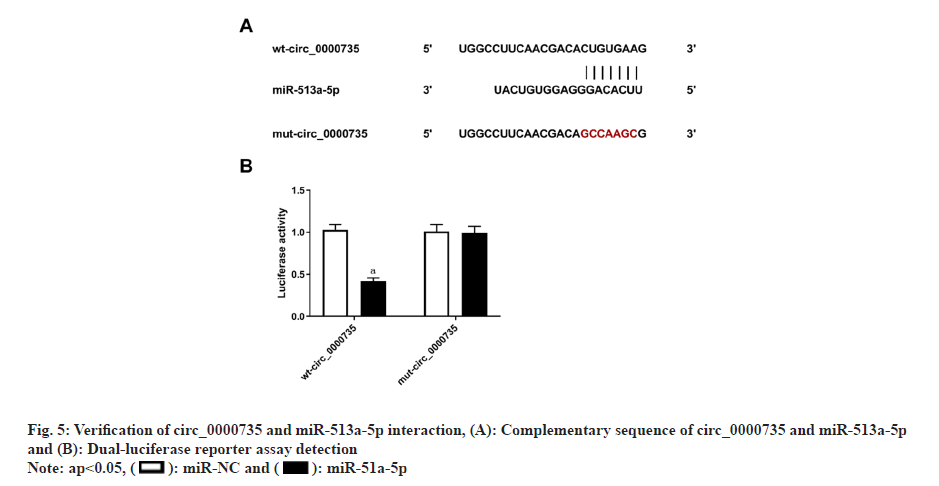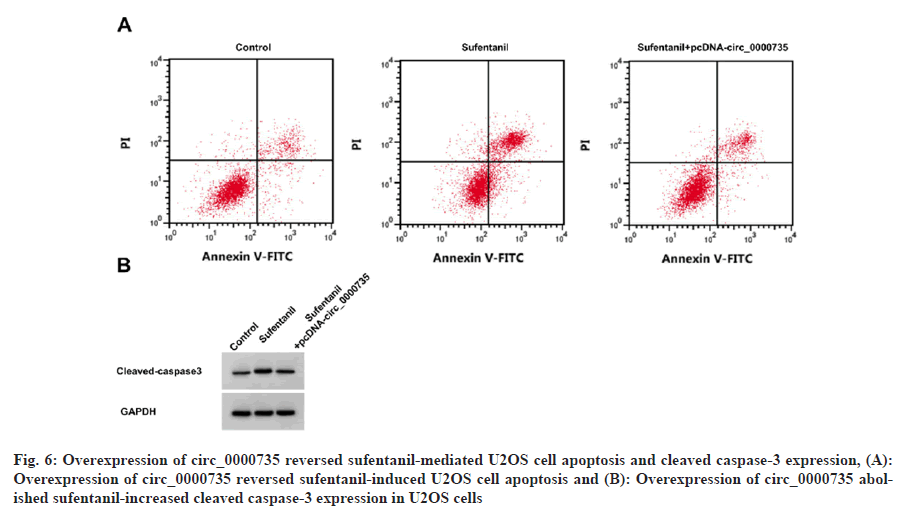- *Corresponding Author:
- Defa Wang Department of Anesthesia, Zhongshan Hospital of Xiamen University, Siming, Xiamen 361004, China E-mail: xmhcwdf@163.com
| Date of Received | 25 January 2023 |
| Date of Revision | 17 October 2023 |
| Date of Acceptance | 03 May 2024 |
| Indian J Pharm Sci 2024;86(3):1051-1057 |
This is an open access article distributed under the terms of the Creative Commons Attribution-NonCommercial-ShareAlike 3.0 License, which allows others to remix, tweak, and build upon the work non-commercially, as long as the author is credited and the new creations are licensed under the identical terms
Abstract
Sufentanil has been found to have anti-tumor effects, but its role in osteosarcoma progression and its underlying molecular mechanisms remain largely unknown. Circular_0000735 and microRNA-513a-5p expression was analyzed by quantitative real-time polymerase chain reaction. Osteosarcoma cells (U2OS) were grouped as control group, different concentrations of sufentanil (10, 20 and 40 ng/ml) group, small interfering-negative control group, small interfering-circular_0000735 group and sufentanil+plasmid cloning deoxyribonucleic acid-circular_0000735 group. Cell growth was analyzed by 3-(4,5-dimethylthiazol-2-yl)-2,5 diphenyl tetrazolium bromide assay, plate cloning assay and flow cytometry. Cleaved-caspase-3 protein level was tested by Western blot. Circular_0000735 and microRNA-513a-5p interaction was confirmed by dual-luciferase reporter assay. Circular_0000735 was upregulated while microRNA-513a-5p was downregulated in osteosarcoma tissues (p<0.05). Sufentanil inhibited U2OS cell proliferation and circular_0000735 expression, while promoted apoptosis rate, cleaved caspase-3 level, and microRNA-513a-5p expression (p<0.05). Circular_0000735 knockdown enhanced microRNA-513a-5p expression, apoptosis rate and cleaved-caspase-3 level, while it reduced cell proliferation (p<0.05). Overexpression of circular_0000735 could reverse the effect of sufentanil on osteosarcoma cell proliferation and apoptosis. Besides, circular_0000735 targeted microRNA-513a-5p to regulate negative microRNA-513a-5p expression. Sufentanil restrained osteosarcoma cell growth through circular_0000735/microRNA-513a-5p axis.
Keywords
Sufentanil, circular_0000735, microRNA-513a-5p, osteosarcoma, cleaved caspase-3 protein
Osteosarcoma (OS), a common malignant bone tumor, is mainly manifests as pain, swelling and dysfunction of bone or adjacent joints[1]. Due to the rapid progression, the prognosis of OS patients is poor, which seriously threatens human life[2]. Combination of surgery with chemotherapy is the main treatment for OS, but its effect is limited[3]. It is still necessary to explore effective methods to affect OS process and provide new ideas for its treatment.
Studies have found that anesthetics can mediate OS malignant progression[4,5]. The opioid analgesic sufentanil is an anesthetic agent with the characteristics of strong analgesic effect and few adverse reactions[6,7]. Previous studies have found that sufentanil can inhibit tumor cell growth to play an anti-tumor activity[8,9]. For example, sufentanil suppressed lung cancer cell proliferation and EMT process via inactivating Wingless-related integration site/Beta (Wnt/β) catenin pathway[10]. Sufentanil restrained breast cancer cell growth and invasion via the regulation of Nuclear Factor Kappa B (NF-κB) pathway[11]. Moreover, sufentanil had an inhibition on esophageal cancer cell proliferation and metastasis through NF-κB and Snail pathway[12]. However, the effect of sufentanil on OS cell functions and its underlying molecular mechanism are still unclear.
Circular Ribonucleic Acid (circRNA) serves a key regulator for OS progression[13-15]. Circ_0000735 had been confirmed to accelerate cell proliferation to promote lung cancer malignant process by targeting microRNA (miR)-635[16]. Moreover, circ_0000735 could facilitate bladder cancer cell growth via sponging miR-502-5p[16]. However, its role in OS progression and the related molecular axis remain unclear. MiR-513a-5p is abnormally expressed in many tumors, which expression is closely related to tumor malignant progression[17,18]. MiR-513a-5p was found to be downregulated in OS tissues, and its high expression could significantly increase the radio sensitivity of OS cells[19]. Bioinformatics software predicted that circ_0000735 had targeted binding sites with miR- 513a-5p. However, whether circ_0000735 affects OS cell functions by regulating miR-513a-5p is still unclear. In this, we discovered that sufentanil can reduce circ_0000735 and promote miR-513a- 5p expression, but whether sufentanil mediates OS progression by circ_0000735/miR-513a-5p axis has not been revealed. Our study aims to investigate the effect of sufentanil on OS cell growth and whether the mechanism is related to circ_0000735/miR-513a-5p axis.
Materials and Methods
Cell culture and grouping:
OS cells (U2OS; Procell, Wuhan, China) were cultured in McCoy's 5A (Gibco, Carlsbad, CA, United States of America (USA)) containing 10 % Fetal Bovine Serum (FBS). U2OS cells were treated with sufentanil (10, 20 and 40 ng/ml) (National medicine approval number: H20054172; Yichang Humanwell Pharmaceutical Co., Ltd., Hubei, China) for 24 h, with nontreated cells as control group. U2OS cells were transfected with the small interfering-circular (sicirc) 0000735 or Negative Control (NC), which were recorded as si-circ_0000735 group and si- NC group. U2OS cells were transfected with plasmid cloning Deoxyribonucleic Acid (pcDNA) circ_0000735 overexpression vector and treated with 40 ng/ml sufentanil, which were recorded as sufentanil+pcDNA-circ_0000735 group.
Quantitative Real-Time Polymerase Chain Reaction (qRT-PCR):
Total RNA was extracted and reverse-transcribed. SYBR Green was used for qRT-PCR with specific primers. Relative expression was tested by 2-ΔΔCt method.
3-(4,5-Dimethylthiazol-2-yl)-2,5 Diphenyl Tetrazolium Bromide (MTT) assay:
U2OS cells seeded in 96-well plates were cultured for 48 h. Then, cells were treated with MTT reagent (Beyotime, Shanghai, China) and were incubated with Formazan which was dissolved into solution. Optical Density (OD) value was detected at 570 nm to count cell proliferation inhibition rate (%).
Plate cloning assay:
U2OS cells were seeded and cultured in 6-well plates for 14 d. Further, the colonies were stained, and colony numbers were counted under a microscope.
Flow cytometry:
The collected U2OS cells were resuspended by binding the buffer and were incubated with Annexin V-Fluorescein Isothiocyanate (FITC) and Propidium Iodide (PI) solution (Abcam, Cambridge, Massachusetts, USA). Cell apoptosis rate was tested under a flow cytometer.
Western blot:
Proteins were extracted, separated and transferred to Polyvinylidene Difluoride (PVDF) membranes. Membrane was incubated with anti-cleavedcaspase- 3 (ab2302), anti-Glyceraldehyde 3-Phosphate Dehydrogenase (GAPDH) (ab9485) and goat anti-rabbit Immunoglobulin G (IgG) (ab205718). Protein signals were visualized using Enhanced Chemiluminescence (ECL) reagent (Beyotime).
Dual-luciferase reporter assay:
Circ_0000735 Wild-Type (WT)/Mutant (MUT)- type sequences were cloned into psiCHECK2 vectors to construct WT/MUT-circ_0000735 vectors. U2OS cells were co-transfected with the above vectors and miR-513a-5p/miRNC. Luciferase activity was tested to assess circ_0000735 and miR-513a-5p interaction..
Statistical analysis:
Data was expressed as mean±Standard Deviation (SD) and was analyzed using Statistical Package for the Social Sciences (SPSS) 20.0 software. Statistical analysis was performed using student’s t-test or Analysis of Variance (ANOVA) and p<0.05 was considered to be statistically significant.
Results and Discussion
As presented in fig. 1A and fig. 1B, circ_0000735 was higher and miR-513a-5p was lower in OS tissues. U2OS cell proliferation inhibition rate, apoptosis rate and cleaved-caspase-3 expression in different concentrations of sufentanil groups gradually increased, while colony numbers gradually decreased (fig. 2A and fig. 2B, and Table 1).
| Group | Proliferation inhibition rate (%) | Colony numbers | Apoptosis rate (%) | Cleaved caspase-3 | |
|---|---|---|---|---|---|
| Control | 0.00±0.00 | 127.67±4.50 | 7.58±0.47 | 0.19±0.02 | |
| Sufentanil | 10 ng/ml | 16.77±1.01a | 103.67±4.19a | 14.79±0.95a | 0.39±0.03a |
| 20 ng/ml | 37.84±2.65ab | 81.67±2.87ab | 19.43±1.09ab | 0.59±0.05ab | |
| 40 ng/ml | 65.22±3.03abc | 58.67±2.49abc | 24.52±1.55abc | 0.76±0.05abc | |
| F | 552.022 | 200.811 | 131.837 | 115.984 | |
| P | 0.000 | 0.000 | 0.000 | 0.000 | |
Note: ap<0.05 to control group; bp<0.05 to sufentanil 10 ng/ml group and cp<0.05 to sufentanil 20 ng/ml group
In U2OS cells, circ_0000735 expression decreased and miR-513a-5p was enhanced by sufentanil in concentration-dependent manner (fig. 3A and fig. 3B).
Fig 3: Sufentanil regulated circ_0000735 and miR-513a-5p expression, (A): Sufentanil inhibited circ_0000735 expression in U2OS cells and (B): Sufentanil promoted miR-513a-5p expression in U2OS cells
Note: ap<0.05 to control group; bp<0.05 to sufentanil 10 ng/ml group and cp<0.05 to sufentanil 20 ng/ml group
We observed knockdown of circ_0000735, circ_0000735 level and colony numbers whereas miR-513a-5p level, proliferation inhibition rate, apoptosis rate and cleaved caspase-3 expression enhanced (fig. 4A and fig. 4B, and Table 2).
| Group | circ_0000735 | miR-513a-5p | Proliferation inhibition rate (%) | Colony numbers | Apoptosis rate (%) | Cleaved caspase-3 |
|---|---|---|---|---|---|---|
| si-NC | 1.00±0.00 | 1.00±0.00 | 0.00±0.00 | 126.67±5.44 | 7.44±0.57 | 0.18±0.02 |
| si-circ_0000735 | 0.28±0.03a | 3.00±0.09a | 52.01±3.51a | 69.00±2.94a | 22.09±0.98a | 0.67±0.04a |
| T | 41.569 | 38.490 | 25.665 | 16.154 | 22.382 | 18.978 |
| P | 0.000 | 0.000 | 0.000 | 0.000 | 0.000 | 0.000 |
Note: ap<0.05, compared to si-NC group
Table 2: Silencing of circ_0000735 Inhibited U2OS Cell Proliferation and Induced Apoptosis
Circular RNA interactive software predicted that circ_0000735 bound with miR-513a-5p (fig. 5A). MiR-513a-5p mimics significantly reduced luciferase activity of WT-circ_0000735 vector rather than MUT-circ_0000735 vector (fig. 5B).
Circ_0000735 level and colony numbers increased, while miR-513a-5p level, proliferation inhibition rate, apoptosis rate and cleaved-caspase-3 expression were inhibited in sufentanil+pcDNAcirc_5257* 0000735 group (fig. 6A and fig. 6B, and Table 3).
Fig 6: Overexpression of circ_0000735 reversed sufentanil-mediated U2OS cell apoptosis and cleaved caspase-3 expression, (A): Overexpression of circ_0000735 reversed sufentanil-induced U2OS cell apoptosis and (B): Overexpression of circ_0000735 abolished sufentanil-increased cleaved caspase-3 expression in U2OS cells
| Group | circ_0000735 | miR-513a-5p | Proliferation inhibition rate (%) | Colony numbers | Apoptosis rate (%) | Cleaved caspase-3 |
|---|---|---|---|---|---|---|
| Control | 1.00±0.00 | 1.00±0.00 | 0.00±0.00 | 127.33±4.64 | 7.59±0.43 | 0.19±0.01 |
| Sufentanil | 0.23±0.03a | 3.45±0.13a | 65.58±3.02a | 59.67±3.40a | 24.64±1.67a | 0.75±0.06a |
| Sufentanil +pcDNA-circ_0000735 | 0.83±0.04b | 1.33±0.05b | 13.14±1.16b | 106.00±2.94b | 10.60±0.67b | 0.29±0.02b |
| F | 589.080 | 820.036 | 1035.260 | 258.043 | 217.760 | 195.805 |
| P | 0.000 | 0.000 | 0.000 | 0.000 | 0.000 | 0.000 |
Note: ap<0.05 and bp<0.05, comparison of control group with sufentanil group
Table 3: Overexpression of circ_0000735 Reversed Sufentanil-Mediated U2OS Cell Proliferation and Apoptosis
There is an evidence that anesthesia is a potential factor affecting the long-term outcome of malignant tumor surgery[20,21]. Most anesthetics can affect the function of the patient’s immune system and the activity of tumor cells [21,22]. As a potent narcotic analgesic, although sufentanil has been shown to have tumor suppressive effects[8-12], its role in OS progression is still unclear. In this study, sufentanil induced the ability of U2OS cell apoptosis and inhibited proliferation, indicating that sufentanil can suppress OS cell growth.
Circ_0000735 plays an important role as tumor promoter in many kinds of cancers. For example, circ_0000735 significantly facilitated lung cancer cell proliferation and metastasis, which was achieved by targeting miR-940[23]. Silencing of circ_0000735 improved the sensitivity of prostate cancer to docetaxel and inhibited tumor growth by regulating miR-7[24]. However, its role in OS remains unclear. Our results suggested that circ_0000735 expression increased in OS tissues. After silencing of circ_0000735, U2OS cell proliferation was reduced and apoptosis was promoted, confirming that circ_0000735 played an active role in OS progression. Zhang et al.[25] revealed that anesthetic propofol could reduce circ_0000735 expression to inhibit lung cancer tumor growth. In this, we found that sufentanil had a decreasing effect on circ_0000735 expression, and further analysis showed that circ_0000735 overexpression overturned sufentanil-mediated U2OS cell growth inhibition, verifying that sufentanil indeed reduced circ_0000735 expression to play anti-tumor activity.
Although Dai et al. demonstrated a low expression of miR-513a-5p in OS tissues, its effect on OS cell growth remains unclear. Consistent with the above results, we confirmed decreased miR-513a- 5p expression in OS tissues. Through analysis and validation, we pointed out that circ_0000735 sponged miR-513a-5p to negatively regulate its expression. MiR-513a-5p expression was enhanced after circ_0000735 knockdown, which in turn inhibited U2OS cell growth, confirming that high miR-513a-5p expression was related to OS cell growth inhibition. In addition, this experiment also found that sufentanil could increase miR-513a-5p expression, while circ_0000735 overexpression depicted increased sufentanil-mediated miR- 513a-5p expression. These results indicated that sufentanil restrained OS cell growth by regulating circ_0000735/miR-513a-5p axis..
Taken together, our study revealed the tumor suppressive effect of sufentanil in OS. Our results showed that sufentanil inhibited OS cell proliferation and accelerated apoptosis via circ_0000735/miR-513a-5p axis. These results provide a new theoretical basis for sufentanil to treat OS and have important clinical implications.
Conflict of interests:
The authors declared no conflict of interests.
References
[Crossref] [Google Scholar] [PubMed]
[Crossref] [Google Scholar] [PubMed]
[Crossref] [Google Scholar] [PubMed]
[Crossref] [Google Scholar] [PubMed]
[Crossref] [Google Scholar] [PubMed]
[Google Scholar] [PubMed]
[Google Scholar] [PubMed]
[Crossref] [Google Scholar] [PubMed]
[Crossref] [Google Scholar] [PubMed]
[Crossref] [Google Scholar] [PubMed]
[Crossref] [Google Scholar] [PubMed]
[Crossref] [Google Scholar] [PubMed]
[Crossref] [Google Scholar] [PubMed]
[Crossref] [Google Scholar] [PubMed]
[Google Scholar] [PubMed]
[Crossref] [Google Scholar] [PubMed]
[Crossref] [Google Scholar] [PubMed]
[Crossref] [Google Scholar] [PubMed]
[Crossref] [Google Scholar] [PubMed]
[Crossref] [Google Scholar] [PubMed]
[Crossref] [Google Scholar] [PubMed]
[Crossref] [Google Scholar] [PubMed]
